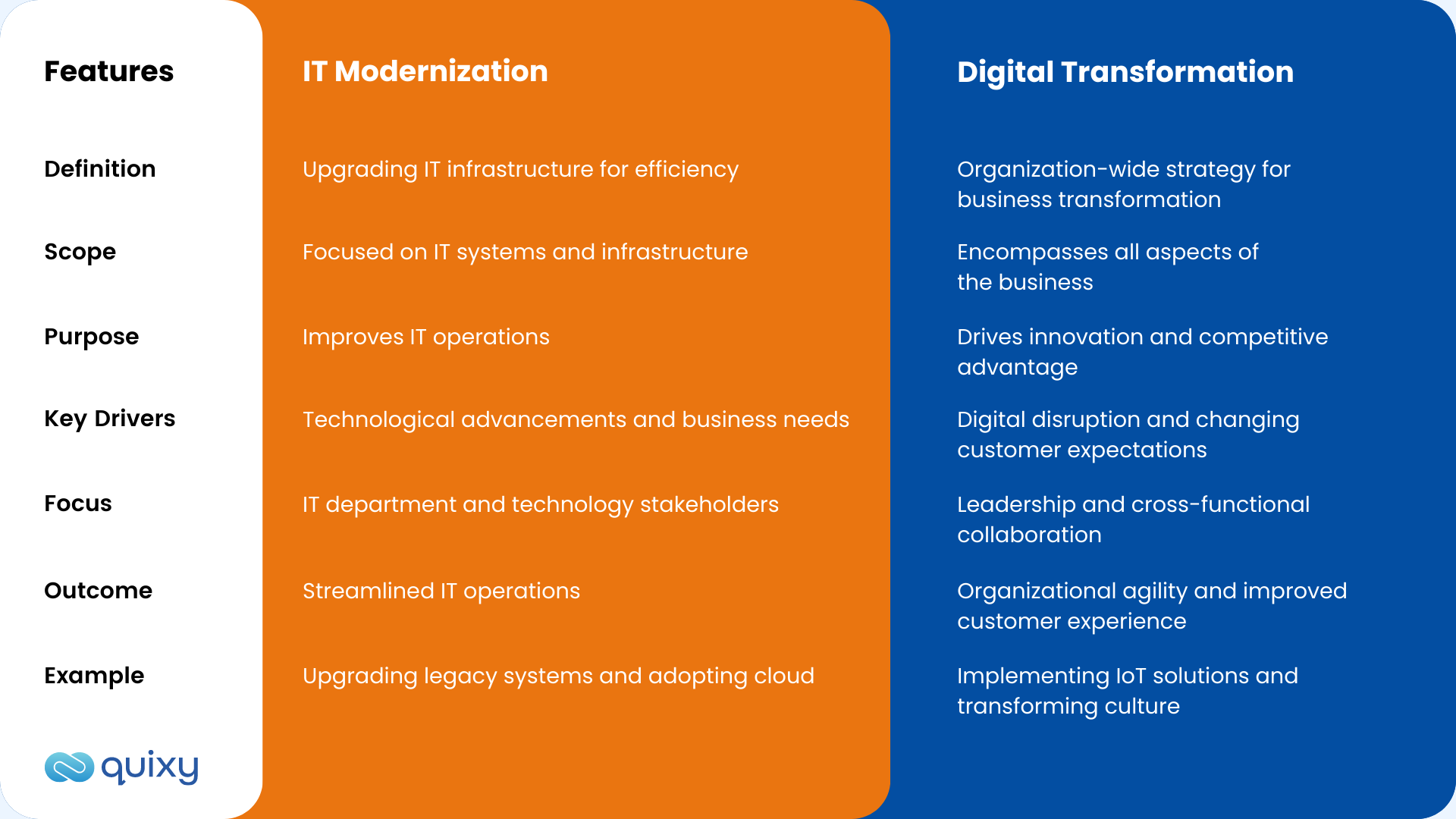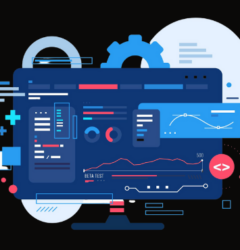
The digital era has witnessed a remarkable evolution of digital transformation and IT modernization. From its early days of automating manual processes and digitizing paper-based systems, digital transformation has evolved into a strategic initiative driving organizational change. Coupled with IT modernization, it has become a powerful force reshaping the technology landscape and propelling businesses into a future of innovation and growth.
What is Digital Transformation?
Digital transformation refers to the use of digital technologies to enhance or create new business processes, fostering a business culture focused on customer perspectives. It aims to raise awareness among users in the market while integrating the latest technologies to drive business growth and innovation.
What is IT Modernization?
The updraging of tech usage and aligning the the business with modern needs is called IT Modernization.It involves in adopting the latest technologies like cloud solutions, integrating AI automation and optimizing legacy systems for better workflow performance.
This transformation enhances digital development in organizations, improves data desions process, stregts cyber security and improves customer experience. Which inreturn builds quick innovations with modern agility with cost-efficient preocdures.
Digital Transformation vs IT Modernization: The Dynamic Duo for Thriving in the Digital Age
In the whirlwind tech world, “digital transformation” and “IT modernization” often cause confusion. But knowing their distinction is key to unlocking your organization’s full digital potential. Dive into the essence of each concept to see how they propel businesses forward in the ever-changing software engineering landscape.

From driving innovation to optimizing IT performance, discover how this dynamic duo synergizes to empower your team and deliver exceptional customer experiences. Embrace the power of transformation and modernization to thrive in the exciting realm of technology!
The Essence of Digital Transformation
Digital transformation is a strategic initiative that goes beyond the mere adoption of technology. It involves fundamentally reimagining and restructuring an organization’s processes, culture, and business model to leverage the full potential of digital technologies . The focus of digital transformation is to drive innovation, enhance customer experiences, drive ROI from digital transformation and stay ahead of the competition in a digital-centric world.
In software product engineering, digital transformation entails creating an agile and customer-centric approach to software development, embracing cutting-edge technologies, and fostering a culture of continuous improvement. This transformative journey empowers businesses to adapt swiftly to market changes, identify emerging opportunities, and deliver software products that resonate with customer needs.
The Significance of IT Modernization
While digital transformation is about reshaping the entire organization, IT modernization zooms in on the technology infrastructure and systems. IT modernization involves updating and upgrading legacy systems, applications, and hardware to align with the latest technology trends and best practices. The primary objective of IT modernization is to enhance efficiency, streamline operations, and optimize IT performance.
In software product engineering, IT modernization focuses on revitalizing development processes, adopting modern tools and methodologies, and leveraging cloud computing and automation to accelerate software delivery and deployment. By modernizing IT, organizations can reduce technical debt, improve software quality, and effectively manage resources to keep pace with the ever-changing software landscape.
Also Read: Digital Transformation vs. Digital Modernization: Which is Better for you?
The Synergy between Digital Transformation and IT Modernization:
While digital transformation and IT modernization have distinct goals, they are inherently interconnected and mutually reinforcing. Digital transformation sets the vision and strategic direction for the organization, defining the “why” and “what” of change. At the same time, IT modernization is the practical implementation, addressing the “how” aspect of the transformation journey.
Successful software product engineering endeavors require a harmonious blend of digital transformation and IT modernization. Digital transformation provides the vision to create innovative software solutions that meet evolving customer needs. At the same time, IT modernization equips development teams with the tools and infrastructure to deliver these solutions efficiently and effectively.
Grasping the difference between digital transformation and IT modernization is paramount for businesses seeking to thrive in the digital age. Embracing both aspects of this transformative journey enables organizations to innovate, improve operational efficiency, and create software products that deliver real value to their customers. By understanding the essence of digital transformation and the significance of IT modernization, software product engineering teams can chart a path to success in the dynamic and ever-evolving landscape of technology.
Also Read: Digital Transformation in Insurance
Digital Transformation Leading to IT Modernization
The evolution of Digital Transformation to IT Modernization is driven by the need to align technology infrastructure and systems with the broader strategic initiatives of digital transformation. As organizations undergo digital transformation to stay competitive and meet customer demands in the digital age, it becomes essential to modernize IT to support and enable these transformative changes effectively. IT modernization ensures that the technology landscape remains agile, efficient, and capable of delivering innovative solutions in the ever-changing digital landscape. This synergy between digital transformation and IT modernization empowers businesses to achieve their objectives and thrive in the dynamic world of technology.
Also Read: IT Modernization Guide: Strategies, Approaches and more.
Journey of Digital Transformation to IT Modernization
Let’s delve deeper into the transformative journey of digital transformation and its impact on IT modernization.
Siloed Systems to Integrated Platforms
In the initial stages, organizations operated in silos, each department using separate systems and applications to manage their functions. However, with the advent of digital transformation, there has been a shift towards integrating these systems into unified platforms. This integration allows seamless data sharing and collaboration across departments, breaking down barriers and fostering a culture of cross-functional teamwork.
On-premises infrastructure to Cloud Computing
Traditional IT infrastructure relied heavily on on-premises servers and data centers, which often came with limitations in scalability and flexibility. The emergence of digital transformation has led to a paradigm shift towards cloud computing. Embracing the cloud offers organizations access to scalable and flexible computing resources, reducing operational costs, and enhancing accessibility, allowing employees to work from anywhere, anytime.
Monolithic Applications to Microservices
Legacy applications were typically built as monolithic systems, where all components were tightly interconnected, making them difficult to maintain and update. With digital transformation, the concept of microservices has gained traction. Microservices break down applications into smaller, modular components that can be independently developed, deployed & scaled, offering greater agility and facilitating faster innovation.
Also Read: The Real Challenges of Digital Transformation to Overcome this year
Waterfall to Agile Development
Traditional software development followed the waterfall approach, where each phase of development followed a linear sequence. However, digital transformation has ushered in the agile era. Embracing agile methodologies allows for iterative development, rapid prototyping, and continuous delivery, enabling organizations to respond quickly to changing market demands and deliver products faster to market.
Data Warehousing to Big Data Analytics
Earlier, data was primarily stored in traditional data warehouses, limiting organizations’ ability to harness its full potential. Digital transformation has carved the way for big data analytics, leveraging advanced technologies like machine learning and artificial intelligence. Organizations can now extract valuable insights from large and diverse data sets, empowering data-driven decision-making and predictive analysis.
Reactive to Proactive IT Operations
Traditional IT operations were reactive, relying on manual monitoring and issue resolution. However, with digital transformation, organizations have embraced proactive approaches to IT operations. Automation, monitoring tools, and predictive analytics enable the identification & resolution of potential issues before they impact business operations, reducing downtime and optimizing performance.
Linear to DevOps and DevSecOps
Digital transformation has led to the convergence of development and operations teams through DevOps. This fosters collaboration, continuous integration, and continuous delivery, breaking down silos and accelerating software development cycles. Additionally, the growing emphasis on security has given rise to DevSecOps, integrating security practices throughout the software development lifecycle, ensuring robust and secure applications.

Traditional IT Roles to Hybrid Skills
The evolution of digital transformation has changed the landscape of IT roles and skill requirements. Traditional roles that focused solely on specific technical areas are now evolving into hybrid roles. Modern IT professionals need to possess a blend of technical expertise and business acumen to navigate the rapidly changing technology landscape effectively.
Conclusion
Digital transformation and IT modernization have evolved significantly, transcending the boundaries of mere automation. They have become strategic initiatives that reshape organizations, processes, and technologies. By embracing these transformative forces, businesses can leverage new technologies, improve efficiency, enhance customer experiences, and stay competitive in the ever-evolving digital world. Embracing a future of innovation, digital transformation, and IT modernization empower organizations to thrive and remain at the forefront of the digital revolution.
Frequently Asked Questions (FAQs)
Q. How has digital transformation evolved over the years?
In the early stages, digital transformation aimed at automating manual processes and digitizing paper-based systems. However, as technology advanced, the scope of digital transformation expanded to include broader organizational changes and strategic initiatives. Today, digital transformation goes beyond just the adoption of technology. It involves fundamentally reimagining and restructuring an organization’s processes, culture, and business model to leverage the full potential of digital technologies.
Q. What is the role of IT modernization in digital transformation?
IT modernization plays a crucial role in digital transformation as it is a key enabler of the overall process. Digital transformation requires organizations to update their technology infrastructure, systems, and applications to align with the latest technology trends and best practices. By modernizing IT, organizations can enhance operational efficiency, streamline processes, and optimize IT performance, making adopting and integrating new digital initiatives easier.
Q. What are the key milestones in the evolution of digital transformation?
The evolution of digital transformation has seen several key milestones. Initially, organizations had separate systems and applications for different functions, leading to data silos and limited collaboration. However, the digital transformation brought about integrating these systems into unified platforms, enabling seamless data sharing and collaboration across departments. Also, a shift from on-premises IT infrastructure to cloud computing has shifted, allowing organizations to leverage scalable and flexible computing resources. Moreover, digital transformation has ushered in agile methodologies, promoting iterative development and continuous delivery, resulting in faster time to market and greater adaptability.
Q. How does IT modernization complement the evolving digital landscape?
IT modernization complements the evolving digital landscape by ensuring that the organization’s technology infrastructure is up-to-date and capable of supporting digital initiatives. With the rapid pace of technological advancements, legacy systems may become outdated and hinder digital transformation efforts. IT modernization involves updating existing systems, adopting modern tools and methodologies, and leveraging cloud computing and automation to enhance the organization’s ability to embrace and benefit from the ever-changing digital landscape.
Q. How can organizations ensure successful digital transformation with IT modernization?
Successful digital transformation requires a well-defined strategy and a holistic approach. Organizations should have a clear vision and purpose for the transformation, involving stakeholders at all levels of the organization. Communication is critical to ensure that everyone understands the objectives and benefits of the transformation. Moreover, organizations should take a phased approach to IT modernization, prioritizing critical areas for improvement and ensuring seamless integration with business goals and customer needs.
Subscribe
Login
Please login to comment
0 Comments
Oldest
















